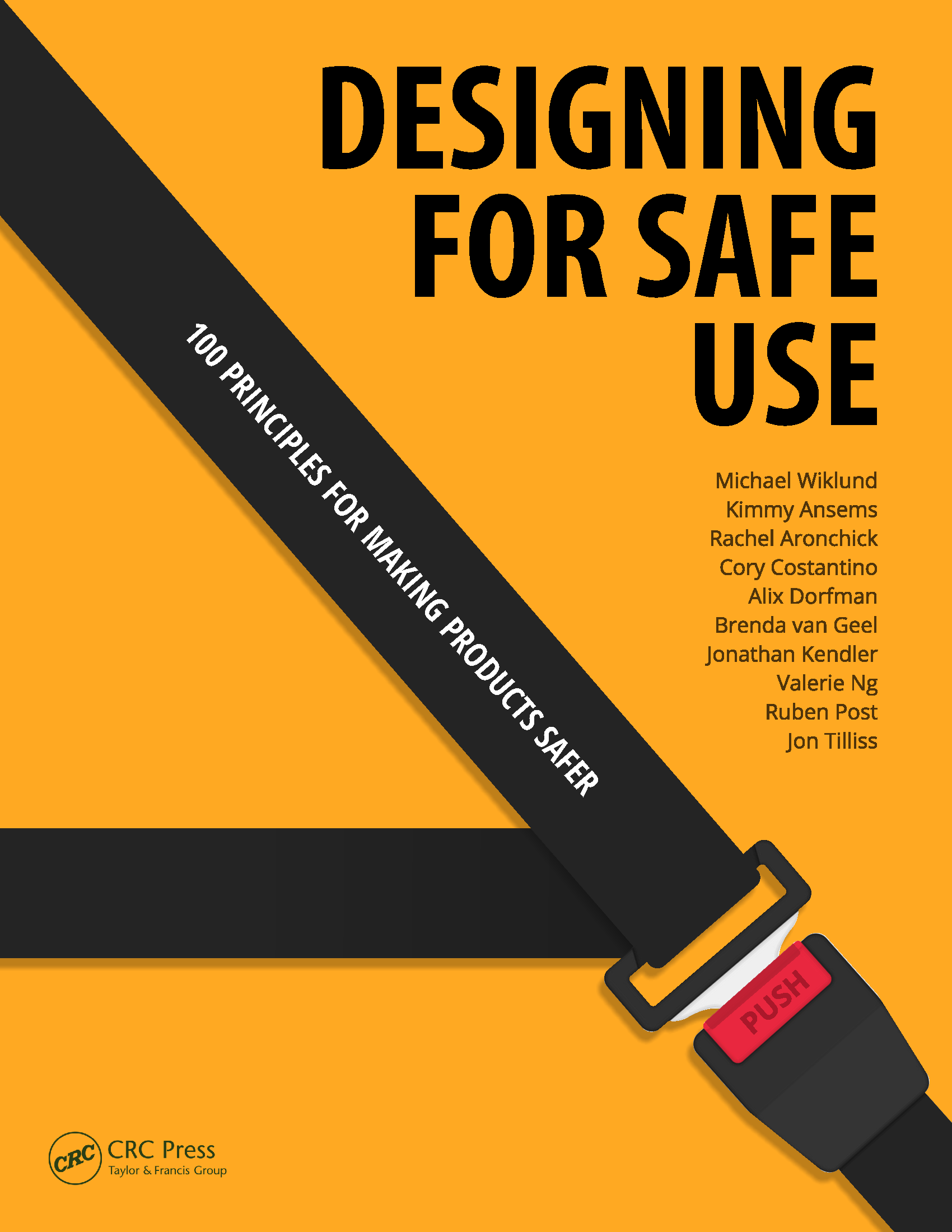
Designing for Safe Use (CRC Press, late 2019)
by Kimmy Ansems, Cory Costantino, Alix Dorfman, Brenda Van Geel, Jonathan Kendler, Rachel Aronchick, Valerie Ng, Ruben Post, Jon Tilliss, and Michael Wiklund
We – this book’s authors/designers – are members of the Human Factors Research and Design (HFR&D) at EMERGO by UL. In this book, we have consolidated the lessons we have learned about designing for safe use, that is, designing products that shield people from harm to the extent possible.
We settled on a target of 100 principles on how to make products safer. The principles pertain to hardware, software, document, and document design. Yes, settling on an even one hundred principles was a bit arbitrary and cliché. The myriad ways to design for safe use do not stop sharply at one hundred. But, we think we covered many of the key ones.
We elected to use the term “product” broadly to cover things one might consider to be systems, machines, equipment, instruments, tools, applications, manuals, and instructions. These are all things that need to be designed properly to eliminate or reduce the chance of harm due to normal use and foreseeable misuse.
Most of the design principles could be addressed in an expanded form; even an entire book of its own. We choose brevity for the sake of communicating core concepts with some fun facts to spice things up.
As you read the book, be mindful that the science and art of making things safe is ever changing and that some of the content we present is sure to age. So, complement our guidance with insights you may gain from other sources, ranging from books to technical articles to standards and more.
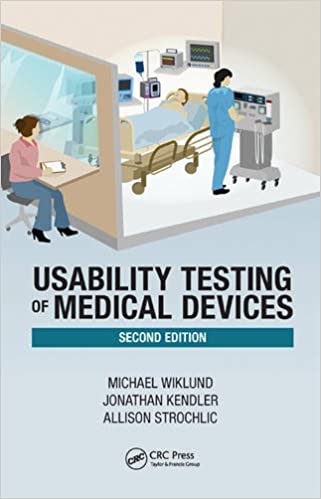
Usability Testing of Medical Devices - Second Edition
by Michael Wiklund, Jonathan Kendler, and Allison Strochlic
Usability Testing of Medical Devices covers the nitty-gritty of usability test planning, conducting, and results reporting. The book also discusses the government regulations and industry standards that motivate many medical device manufacturers to conduct usability tests.
Since publication of the first edition, the FDA and other regulatory groups have modified their regulations and expectations regarding how medical device manufacturers should approach usability testing. Reflecting these changes, this Second Edition provides updated guidance to readers with an interest or direct role in conducting a usability test of a medical device or system. Key updates involve the 2011 FDA guidance on human factors engineering, requirements set forth by the third edition of IEC 60601 and closely related IEC 62366-1:2015, linking usability test tasks to risk analysis results, and analyzing root causes of use errors that occur during usability tests.
Written by seasoned human factors specialists, Usability Testing of Medical Devices, Second Edition is an informative, practical, and up-to-date handbook for conducting usability tests of medical devices. The book explains a smooth and painless development process―and thus, safe and effective medical devices.

Writing Human Factors Plans and Reports for Medical Technology Development
By Michael Wiklund, Laura Birmingham, and Stephanie Larsen
This book provides the foundation for developing specific human factors engineering (HFE) work products that are needed to meet the FDA's human factors engineering (HFE) guidance. The authors have created a fictitious company and product to generate concrete examples of the plans and reports developed during various stages of HFE. The book includes an HFE project plan, a formative usability test plan and report, a summative (i.e., validation) usability test plan and report, and an HFE report. These work products and additional content outline the activities necessary to develop safe and effective medical devices, making this book an ideal resource for anyone interested in the medical technology field.

Medical Device Use Error Root Cause Analysis
by Michael Wiklund, Andrea Dwyer, and Erin Davis
This book offers practical guidance on how to methodically discover and explain the root cause of a use error―a mistake―that occurs when someone uses a medical device. Covering medical devices used in the home and those used in clinical environments, the book presents informative case studies about the use errors (mistakes) that people make when using a medical device, the potential consequences, and design-based preventions.
Using clear illustrations and simple narrative explanations, the text:
- Covers the fundamentals and language of root cause analysis and regulators’ expectations regarding the thorough analysis of use errors
- Describes how to identify use errors, interview users about use errors, and fix user interface design flaws that could induce use errors
- Reinforces the application of best practices in human factors engineering, including conducting both formative and summative usability tests
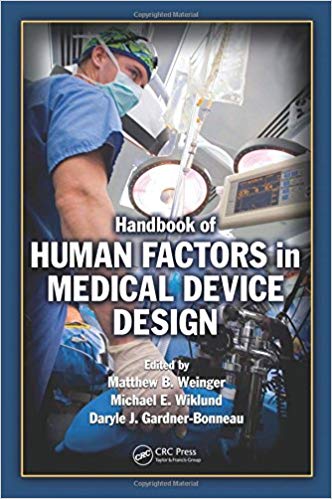
Handbook of Human Factors in Medical Device Design
Edited by Matthew Weinger, Michael Wiklund, and Daryle Gardner-Bonneau
Developed to promote the design of safe, effective, and usable medical devices, Handbook of Human Factors in Medical Device Design provides a single convenient source of authoritative information to support evidence-based design and evaluation of medical device user interfaces using rigorous human factors engineering principles. It offers guidance on user-centric design supported by discussions of design issues, case studies, and examples.
The book sets the foundation with coverage of fundamental topics such as aligning the interactive nature of medical devices to the expected use environments ranging from hospitals and ambulances to patients’ homes, drawing on anthropometric and biomechanical data to ensure that designs match the intended users’ bodies and physical abilities, and conducting usability tests and other evaluations to verify that devices perform as intended. It then focuses on applied design issues, offering guidance on the design of specific types of devices and designing devices for particular use environments. Adapted in part from established design standards and conventions, the design guidance presented in this work distills professional judgment extracted from the contributing authors’ years of experience in applied analysis and design.
Written in true handbook style, each chapter stands alone and includes tables, illustrations, and cross references, allowing you to quickly find the exact information you need. Most chapters begin with a general introduction to the selected topic, followed by the presentation of general and special design considerations and then specific, numbered design guidelines. The book also presents a listing of resources, literature, and website references. It not only focuses on the human factors issues that arise when developing medical devices, it supplies the necessary guidance to resolve them.
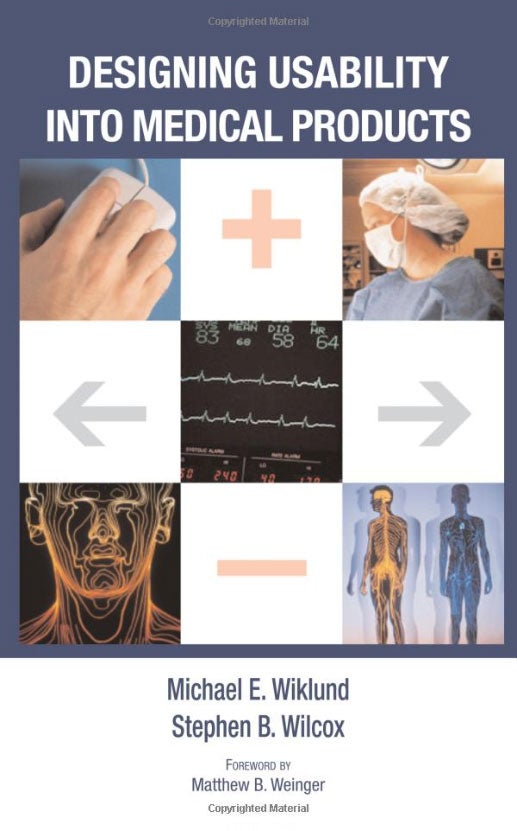
Designing Usability into Medical Products
by Michael Wiklund and Stephen Wilcox
Advocating a user-centered approach to medical technology design, Designing Usability into Medical Products covers the essential processes and specific techniques necessary to produce safe, effective, usable, and appealing medical systems and products. Written by experts on user-centered research, design, and evaluation, the book provides a range of alternative approaches to the subject. Wiklund and Wilcox explore how to make medical devices safe and effective by involving users in the design process. They discuss specific design and evaluation methods and tools, present case studies of user-friendly medical technologies and corporate human factors programs, and supply related resources for medical design professionals.
The book conveys an in-depth understanding of the user-centered design process, covers design methods for FDA compliance, and offers guidance on performing a variety of hands-on user research, user interface design, and user interface evaluation. The authors make a compelling case for treating the user's needs and preferences as a top design priority, rather than an afterthought. They demonstrate that high-quality customer interactions with systems and products leads to effective medical diagnosis and treatment, increases the physical and mental well being of patients and caregivers, and leads to commercial success in a crowded marketplace.
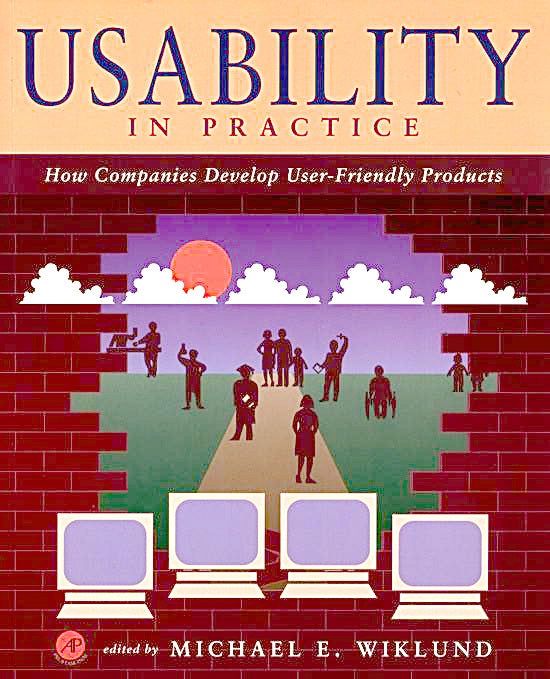
Usability in Practice
Edited by Michael Wiklund
This volume investigates how major corporations, such as Microsoft, Borland, Apple, Eastman Kodak, and Silicon Graphics, address usability issues. It presents case studies of each organization, outlining their program structures, program goals, and team members' responsibilities and resources. The book also addresses how usability is marketed inside the organization and to customers, as well as the lessons learned during the course of product development efforts. Each illustrated study includes advice that should help readers establish and manage their own program.
Out of print. Used copies might be available.
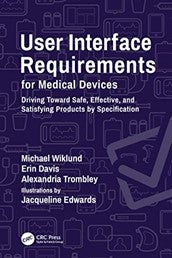
User Interface Requirements for Medical Devices: Driving Toward Safe, Effective, and Satisfying Products by Specification
by Michael Wiklund, Erin Davis, and Alexandria Trombley
This book is a practical guide for individuals responsible for creating products that are safe, effective, usable, and satisfying in the hands of the intended users. The contents are intended to reduce the number of use errors involving medical devices that have led to injuries and deaths. The book presents the strong connection between user interface requirements and risk management for medical devices and instructs readers how to develop specific requirements that are sufficiently comprehensive and detailed to produce good results – a user-friendly product that is likely to be used correctly. The book’s tutorial content is complemented by many real-world examples of user interface requirements, including ones pertaining to an inhaler, automated external defibrillator, medical robot, and mobile app that a patient might use to manage her diabetes. The book is intended for people representing a variety of product development disciplines who have responsibility for producing safe, effective, usable, and satisfying medical devices, including those who are studying or working in human factors engineering, psychology, mechanical engineering, biomedical engineering, systems engineering, software programming, technical writing, industrial design, graphic design, and regulatory affairs.
Request more information from our specialists
Thanks for your interest in our products and services. Let's collect some information so we can connect you with the right person.



